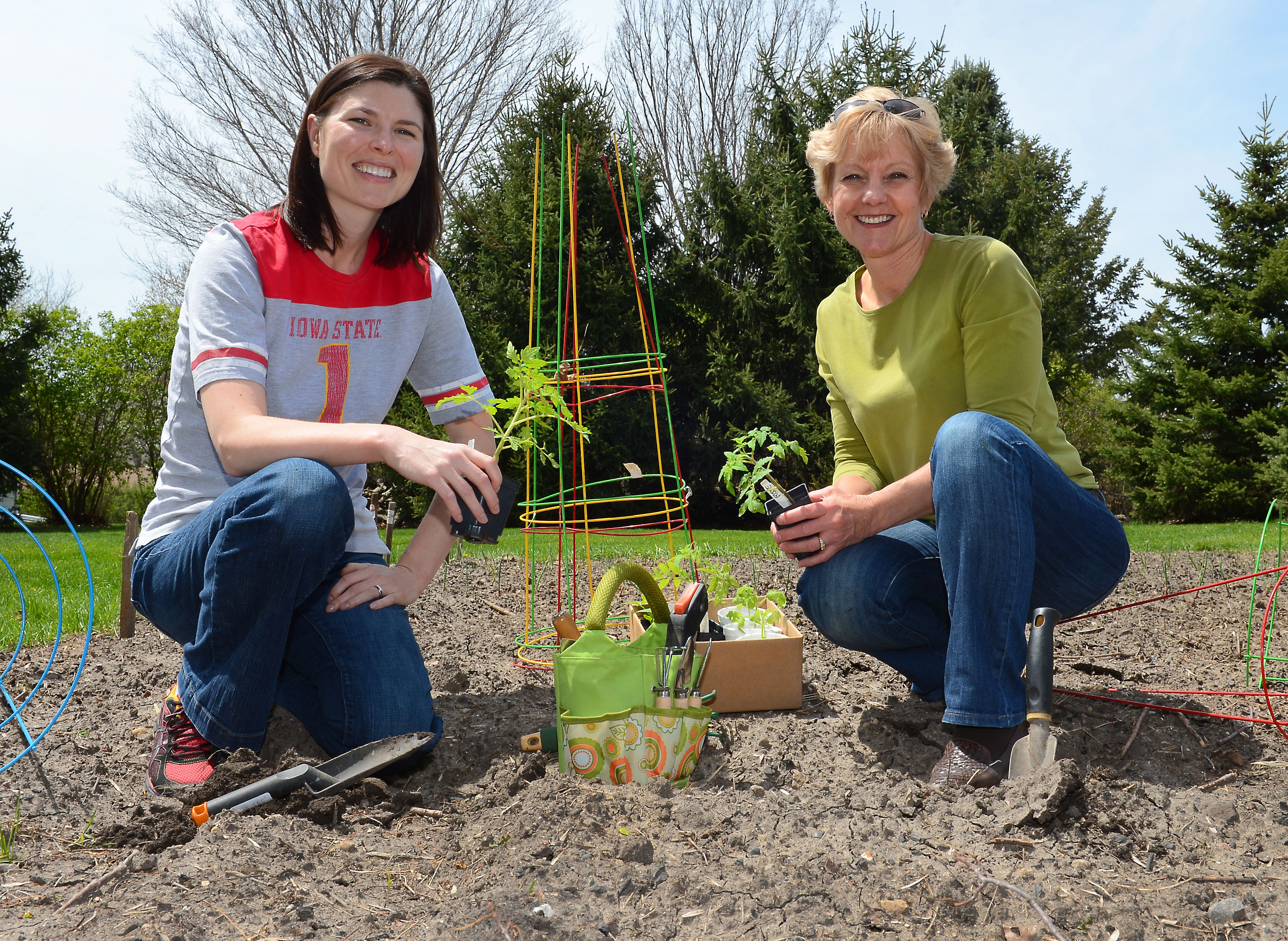
Planting a garden is just one option that Erin Bergquist (left) and Linda Naeve recommend for people interested in local foods. Photo by Bob Elbert (Larger image)
AMES, Iowa – Interest in local, sustainable food sources is motivating more people to plant their own gardens each spring or shop their local farmers market for fresh produce. As a result, registered dietitian nutritionists are fielding more questions from clients about what to plant, how to plant it, and when certain fruits and vegetables are in season.
The answers to those questions can depend on the space and commitment an individual or family has to maintain a garden, as well as their access to farmers markets. Erin Bergquist, a clinician with the dietetics internship program at Iowa State University, recommends finding an option you can stick to and enjoy.
“There are so many options for incorporating local foods into your diet and consumers can pick and choose what works best for them,” Bergquist said. “For example, my family bought a CSA share when we moved to our new house and didn’t have a garden. Now that I have a garden and chickens, I rely on co-ops for local meat, milk, yogurt and other items I choose not to grow myself.”
If you don’t have the space or time for a large garden, Bergquist suggests starting a container garden and planting some of your favorite foods in pots or growing fresh herbs on your windowsill. Farmers markets are a great alternative for those who don’t have a green thumb, but want to incorporate more local foods into their diet.
Bergquist says consumers can also buy directly from farmers at roadside stands, U-pick farms or by buying a share in a CSA or Community Supported Agriculture program. Most CSA shares include weekly deliveries of seasonal produce during the spring and summer months. Iowa State Extension and Outreach also offers an online guide to help you select fresh fruits and vegetables in season as well as other tips for preparing and storing produce. The Extension and Outreach Hortline (515-294-3108) is another good resource for all types of gardening questions.
New training for registered dietitians
The local food movement is relatively new for most registered dietitians, who have some of the same questions about sustainable food and water systems as consumers. Bergquist helped author new standards for dietitians published in the Journal of the Academy of Nutrition and Dietetics. She is also part of a group working to develop an online tool that dietitians can use to rate their knowledge of these issues. The goal is to give dietitians the information and resources they need to better help consumers.
“There is a demand. People want to get in touch with where their food is coming from and dietitians are a good fit to meet that need for consumers,” Bergquist said. “It’s really about customer service and training dietitians to meet the customer where they are, whether it’s simply identifying foods that come from the state, foods that are grown in season, or where to find a farmers market or food co-op.”
Sustainability is also an important issue for Bergquist, who through her work in Ghana understands the importance of a clean water supply. It’s a resource she feels too many people take for granted. As part of their work to help people live healthier lives, dietitians can also educate consumers on best practices to promote a safe and renewable food and water system for future generations.
“Truly it’s about being a good citizen to our planet. We really need to be aware of sustainability and the environment and making sure that our resources last forever. Water is one thing we take for granted here in Iowa and in the U.S.,” Bergquist said.
Small changes, such as composting fruit and vegetable scraps rather than throwing them in the trash or disposal, can make a difference. Using a rain barrel to collect rain water to use in the garden is another simple conservation effort.
Share harvest with those in need
Anyone who has planted a garden has likely had more tomatoes or zucchini than they can use at one time. Instead of letting those extra vegetables go to waste, Linda Naeve recommends donating the items. Naeve, an ISU Extension and Outreach program specialist, and student intern Joy Middleton Niklasen started a Plant a Row program in Story County in 2003. Modeled after the national program, Plant a Row accepts weekly donations of fresh produce to benefit those in need.
“Fresh produce is a luxury many of our local food pantries cannot afford to provide, but can definitely use to serve clients,” Naeve said. “The Plant a Row program is a great way to meet that need, and it gives residents a means in which they can help fight hunger in their own community.”
In Story County, donations are collected at Reiman Gardens on the Iowa State campus from 7:30-9 a.m. every Monday from June 23 through October 20. Last year, the program collected more than 6,500 pounds of fresh vegetables, fruit and herbs that were donated to Food at First, ACCESS, and the food pantries at Story County Mid-Iowa Community Action or MICA, the Salvation Army Ames Service Center, and Bethesda Lutheran Church.
Since the program started in Story County, Plant a Row has collected more than 44,700 pounds of produce. Volunteers also collect donations from vendors at the North Grand Farmers Market and use cash donations to buy produce from local producers to supplement food donations.